Family : Crocodylidae
Subfamily : Gavialinae

Text © DrSc Giuliano Russini – Biologist Zoologist

English translation by Mario Beltramini
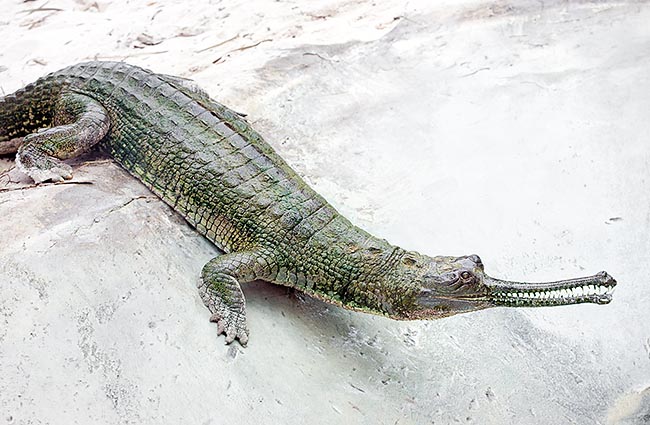
Gharial (Gavialis gangeticus) is a zoological rarity which risked extinction © Giuseppe Mazza
The Indian government, by seeking the worldwide help, has tried, from the second half of the XX century, to protect and to succeed in reproducing those which, by that time, were the last three hundred wild survivors. In 1968, the Zoological Society of India (ZSI), the greatest local zoological organization performed a first demographic survey, following an interpellation advanced by the International Union for Conservation of Nature and Natural Resources (IUCN) which wanted to know the health status of this species of reptilian in the wild, in order to see if the same had to be inserted into the red book of red list (red data book) which was starting to fill out.
From this census, the Indian biologists presented a sad reality: the gharial had disappeared from the locations where, previously, was abounding. From here, a serious and precise scientific inquiry did commence. The Indian government, alarmed, sought for help, including the necessary equipments, from the Wildlife Preservation Organization of the state of the Uttar Pradesh, of Madras Snake Park and of the United Nations (UN). As a result of this substantial scientific inquiry, the previous data supplied by the ZSI were confirmed. This antediluvian reptilian is nowadays more numerous if compared with the few hundreds of specimens of the last century, but, by sure, its conservation is not yet completely succeeded, with its population standing in a delicate balance.
Its natural history tells us that the gharial represents a rarity in the already meagre ranks of the gigantic crocodiles of the Mesozoic, that is the Secondary era, which is what biologists qualify as the geological Middle Ages, which began 225 million of years ago and lasted for 165 million of years. In the many forms of the animal life, it is ascribed (like in the vegetal, the fungal, the protistological and the moneral ones), the Evolutive History of the life on Earth, it is rightly the present and past (by means of the fossiliferous remains) biological diversity, together with the paleo-ambient and palaeogeographic data, which allows the biologists to trace an outline as truthful as possible.
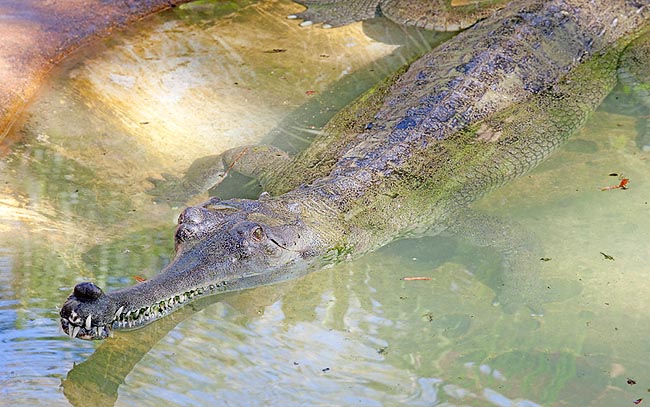
Feels the cold but not keen to leave water, often emerges for basking © Giuseppe Mazza
As already mentioned in the introductory text on the Crocodiles (Crocodylia), the family of the Crocodylidae is, by now, and by the taxonomical biologists, subdivided into three subfamilies: the actual Crocodiles (Crocodylinae), the subfamily of the Alligators (Alligatorinae) and, finally, that of the Gharials (Gavialinae), which counts only the species treated in this text. The members of this last subfamily differ significantly from the members of the species of the other two subfamilies, including also from the so-called false Gharials (Tomistoma schlegelii). Many herpetological biologists think that the gharial has followed, for long time, its own evolutionary cycle well different from that of the common ancestors. In the past, this subfamily included two genera: Ramphosucus, with the extinct species Ramphosucus indicus and the present surviving genus Gavialis, with the only species Gavialis gangeticus.
Only fossil remains of the gigantic Ramphosucus (which was even 15 m long), have reached us: this reptilian, as a matter of fact, lived in the Cenozoic, by the end of the upper Tertiary. Already in that remote period, the gharials have differentiated from the other crocodiles, due to the particular shape of the bones of the skull. In the Mesozoic, the gharials had populated many regions of the Earth; this is what we can deduce from the fossil remains of bones found even in South America. However, starting from more recent historical times, the gharial is found only in the rivers of Pakistan, northern India, Bangladesh and Burma.
As is the case of the other reptilians, also this crocodile has aroused the interest of the XIX century biologists; even if we hold only a few dozen of exact descriptions of the gharial, in the times of its maximum expansion. From these texts, it appears that the gharial was abundantly represented in the river areas of the northern Indian subcontinent. There was a wide range of rivers which were famous for the big quantity of crocodiles populating them.
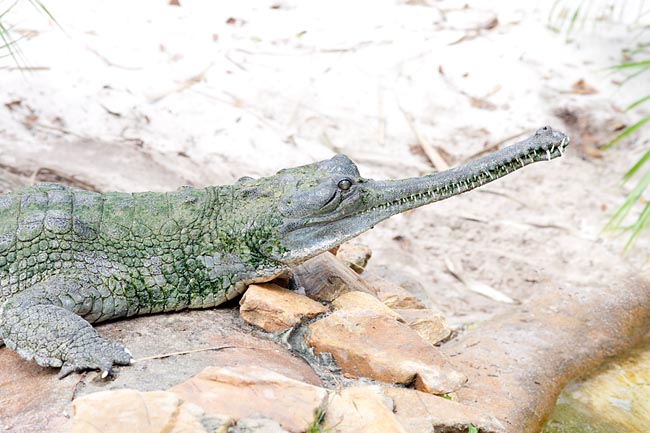
The narrow and long snout is good for seizing fish, its main course © Giuseppe Mazza
Even during the years of the last post-war, when India became independent from the UK, the gharials were still frequent, but during the following troubled years, nobody did realize that these animals had gradually begun to disappear due to the stubbornly persevering hunt. At a certain point the herpetological biologists thought that these reptilians had to be included into the extinct species. The Gharial (Gavialis gangeticus) is so called in the Hindi language; many data about their biology are nowadays available, work of Indian as well as stranger biologists, but it is indeed almost impossible to reconstruct in detail the history and the strenuous strifes this reptilian had to fight, since numerous generations, for surviving up to our days. In fact, along the more than 5.000 of river where they do live, there is no more any “nucleus” of individuals of its species, capable to keep alive and reproduce without the help of man.
Zoogeography
It is endemic to the Eastern region, in particular in the water streams of northern India and of Nepal. It is particularly, nowadays, found in the Ganges catchment which has chosen as dwelling, and is considered as sacred (even if this has not hindered their hunting), it is present also in the Brahmaputra, Chambal, Girwa, Naraynai rivers and in other Indo-Chinese rivers (and relevant loops and lateral channels), such as the Koladan.
Ecology-Habitat
The gharials depend on water much more than the other crocodiles (actual crocodiles as well as alligators). It happens rarely that they leave the water for moving on land; and yet they love the sun, therefore they spend most of their time on the surface of the vital liquid; they often sleep with their eyes closed, even if, by the least suspicious sound, they open wide their eyes keeping still. In the specific, the females get out from the water for spawning and much more rarely, the males. In any case, their ambulation on land is clumsy and slow: their legs are much shorter and weaker than the other crocodiles, reason for which they move dragging as they are unable to lift completely their belly from the soil. When the waterfront, as soon as they sight a man, they tumble down into the water, so much ancestral is the relationship of love and hate between these reptilians and the human being, their hunter and fisher.
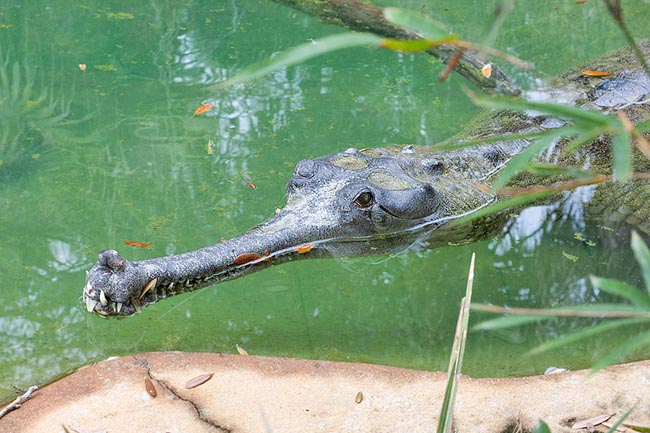
The skull is particular and males have a typical truffle-shaped nose © Giuseppe Mazza
Their docility is confirmed by the fact that the Indians swim in the sacred Ganges River together with them; something unthinkable with the crocodiles or the alligators.
These reptilians prefer the lotic waterways (rivers, streams) with slow and ample course, to the lentic ones (lakes, swamps, lagoons, etc.), and have a piscivorous alimentation, even if they can nourish of some water or amphibious serpent, waterfowls and carrions of large animals.
The sacred Ganges River is full of charred human corpses, as a consequence of the funerary and religious animistic rites of the various Indian sects and tribes, and the gharials present in these rivers do not disdain the human flesh, and in fact it is not rare to find, in their stomach, the bracelets, the necklaces and the rings which adorned the remains of the corpses. The technique used by these animals for hunting these big fishes is quite fascinating: they pinch the prey with a quick bite for shocking it, and after this, like real jugglers, they throw it up in the air and then swallow it.
However, their alimentary ecology, mainly ichthyophagous or piscivorous, has generated an adaptation of the longirostral morphology of the snout, which results in being one of the thinnest and longest amongst all crocodile’s species. Being the fish the main food for these reptilians, in areas where, such as in India and Nepal, million hungry people are decimating the fish stocks for eating, these crocodiles cannot survive or at least will suffer for this, finding in the human being an alimentary competitor; also because, seen their size, they need big quantities of food each day for meeting their requirements. For such reason, for instance, the government of Uttar Pradesh, since the eighties of the XX century, has prohibited fishing in the Chambal River, called also “river of revenge” (where still now fluvial banditry does exist), present in the Kanha National Park. On the other hand, the tribal populations of the Maharajas and the Nababs have been hunting these reptilians for years, killing hundreds of them each day, in order to sell their skin and eat their flesh.
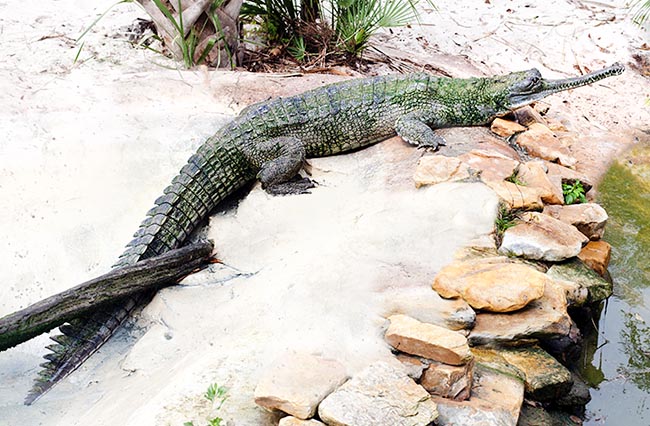
Size is imposing: even 7 m long with one ton of weight © Giuseppe Mazza
The adults of gharial, both males and females, prefer the deep waters of the water streams where they live, whilst the juveniles love keeping in the low inlets forming between the rapids. And there, the young and inexperienced animals easily fall prey of the fishermen and of the poachers.
Nowadays, the rivers where the gharials can reproduce relatively unhindered are three only: the Narayani and the Girwa, which have their sources in the Himalaya, and the Chambel, whose sources are located in the mountains of central India. The reason is quite simple, whilst the Girwa flows in a protected zone and the Narayani crosses a National Park, the Chambal, due to the impervious and inaccessible territory surrounding it, hosts the most favourable conditions for being their ideal refuge, and, in fact, the geographic area where this river is located has been done National Park.
Morpho-physiology
Even a layman is today capable to recognize at first glance a gharial, due to the particular shape of the head and of the snout: the head, getting thinner suddenly in front of the frontal region, just under the orbits of the eyes, continues in a very long and narrow snout, with almost parallel margins, quite distinct from the other parts of the skull. This typical snout, whose length is about three and a half times bigger than the width, expands by the front end, at the region where the nostrils do open, which, in the male, swells like a truffle, this growth is called “ghara” (from the name of an ancient Indian pot in earthenware), from which the common Indian name of “Gharial” for this reptilian; the function of this structure, present only in the males, is not yet clear to the herpetological biologists, who, however, rightly define it as a permanent character of sexual dimorphism, in reality, it is the only one (apart the sizes somewhat differing between the sexes), known between male and female; some zoological biologists have assumed that this structure acts as amplifier of the cries and sounds the male emits, when is in heat.
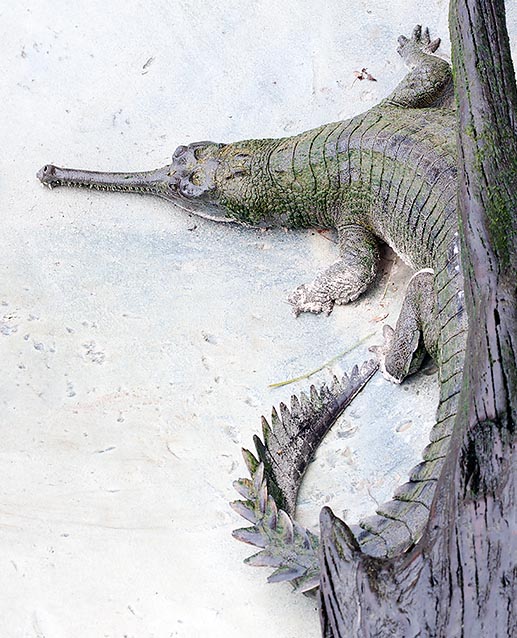
Females dig nests on the high river banks far from floods risks © Giuseppe Mazza
The gharial is the largest crocodile, only the estuarine or Indo-Pacific or estuarine crocodile of Oceania and Indonesia (Crocodylus porosus), equals it, or, maybe, exceeds it in length and weight.
The males can be seven metres long, as an average, they are six metres long, the females are a couple of metres shorter; the weight may exceed the ton.
The teeth are sharp, thin and turned backwards in number of 100-102, of which 55 belong to the upper jaw; the fore ones are more developed than the lateral ones.
When the animal keeps the mouth shut, the first three mandibular teeth are contained in appropriate gingival pouches, placed at the margins of the jaw.
The herpetological biologists have identified another characteristic typical of the gharials: the nuchal scutes are joined with the dorsal ones, and thus form a protective armour; in the other crocodiles the above are separated. The ventral part of the body has no bone plates, which, on the contrary, are present along the sides and the legs.
These last ones, as mentioned before, are shorter and weaker than those of the crocodiles, and for this reason when the gharial moves on a bank, it belly-slides; but, compared with those of other crocodiles, they have a comb-shaped crest in relief, formed by the succession of keeled plates.
Considered sacred to the god Vishnu, the Gavialis gangeticus, or Gharial, is still now a much undervalued reptilian, but in reality it holds many answers concerning the evolution of the reptilians.
It is not to be mistaken with the gharial, a seemingly akin species, which is assigned to the family of the Crocodylids (Crocodylidae), the Tomistoma, or false gharial (Tomistoma schlegeli). This “false gharial” has a thin snout, long from three to four and a half times the width at the base; it recalls for this feature the gharial, but the biggest individuals (the males), may reach, at most, the five metres of length, and have a sallowish colouration (whilst this one in the gharial is saurian grey-green), with dark transversal bands or with darker spots. The anatomical structure affects its alimentary ecology, which is similar to that of the gharial and is docile like it. This species, however, is found on the Sumatra and Borneo islands and in the Malaysian peninsula, where it lives in the rivers, lakes and swamps.
Ethology-Reproductive Biology
The gharial female, when sexually mature, which happens by the eleventh year of life, joins other four-five females and reaches the harem of a male. The mating takes place at the beginning of the winter and after three or four months at most, the expectant mother begins to dig, during the night, several “trial nests”, preferably on the high banks of the river, in way that any increase in the water level does not destroy its work. This work lasts almost a whole month, till when, by the beginning of April, the female gharial lays its eggs.
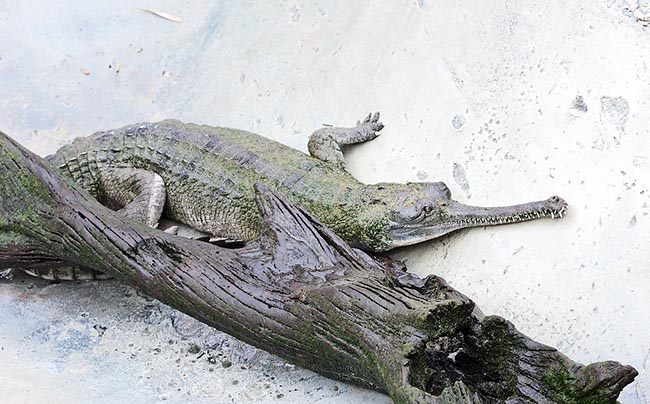
They lay about 40, 9 cm long, eggs which they survey till hatching. 30-40 cm long newborn © Giuseppe Mazza
As an average, the juveniles measure 30-40 cm, of which more than half belongs to the tail.
Their livery is grey, more or less brownish and striated transversally; they leave immediately the dry land for reaching the water where they begin to nourish of insects, arthropods, insects larvae, molluscs, small crustaceans, pollywogs and small fishes.
During the winter season, the adults tend to live closer to the bottom, because they badly tolerate the rigid temperatures, whilst in summer they float on their back, as they love the sun, in fact they are really thirsty of it; rarely they do bask on the banks. Whilst the juveniles prefer the troubled waters, entering the crevices between the rapids, the adults love the mobile waters more than the still ones, provided they are not too fast.
At times, the weakest adult specimens migrate to the conquest of their own reserve, where they may live, undisturbed. Especially during the Monsoon season, along with the juveniles who are looking for a partner, they let themselves be transported by the swollen waters of the rivers, thus generating a modest diffusion of the species. In special breeding centres which operate like real and proper nurseries, such as in the “Kukraie Crocodile Rehabilitation Center” of the state of the Uttar Pradesh, the eggs of gharial, once collected by the biologists in the reserve, avoiding that they are eaten by the jackals, monitor lizards or stolen by the poachers, undergo artificial incubation. Then, the newborn are nourished and cared. The biologists of the “State Project Gharial” have, in such way, the opportunity to study thoroughly this reptilian.
→ To appreciate the biodiversity within the CROCODYLIA and find other species please click here.
→ For general information about CROCODYLIA please click here.
